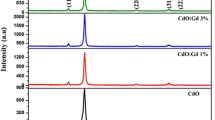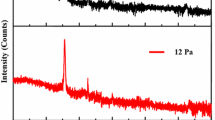Abstract
In this work, ternary CdxZn1−xO (x = 0.05) thin films were deposited on Corning glass substrates using pulsed laser deposition (PLD) growth technique. Films were grown in environment of oxygen flown into the PLD chamber at pressures of 5, 20 and 40 mTorr. XRD studies revealed wurtzite crystal structure and a highly (002)-preferred orientation for all films. The influence of oxygen pressure on FWHM and lattice constants was recorded. UV-Vis transmittance studies indicated that carrier concentration resulting from the oxygen vacancies in films strongly affects band gap energy. This was confirmed by evaluating carrier concentrations and electrical resistivities of films using a four-probe Hall effect measurement set-up at 298 K. Films grown in 20 mTorr oxygen pressure reported the highest carrier concentration of 1.57 × 1015 cm−2, while registering the lowest energy band gap of 3.2 eV, hence making it a critically important pressure for film growth.
Access provided by Autonomous University of Puebla. Download conference paper PDF
Similar content being viewed by others
1 Introduction
Current progress in epitaxial techniques allows combination of ZnO with CdO [1] to obtain cadmium alloyed zinc oxide. CdxZn1−xO can yield theoretical band gaps ranging from 2.37 eV (x = 1.0) to 3.37 eV (x = 0.0), and as such, it becomes useful in construction of appropriate hetero/quantum well structures for optoelectronic applications [2]. With respect to solar cells, this ensures utilization of the blue and green regions of the spectrum and therefore better photon absorption.
2 Aim of the Study
This study aims to investigate the influence of ambient oxygen pressure on structural, optical and electrical properties of Cd0.05Zn0.95O thin films. CdO has a higher vapor pressure than ZnO which necessitates the need to optimize the ambient pressure, besides achieving good quality of films.
3 Methods
To grow Cd0.05Zn0.95O thin films, sintered target pellets using ZnO and CdO powders (99.99% purity) were prepared using hydraulic press method. A background pressure of 5 × 10−6 Torr was achieved to evacuate the PLD chamber. A KrF excimer laser (λ = 248 nm, 20 ns, 10 Hz) was used as the ablation source. Thin films were grown on Corning® glass substrates at 573 K in oxygen ambient at pressures of 5, 20 and 40 mTorr. All deposited films had an average thickness of 1 µm, as measured using a Veeco Dektak 150 profilometer. Crystallographic studies of the films was undertaken using PANalytical PW 3050/65 X-Pert Pro MRD high resolution X-ray diffraction (HRXRD) system with Cu Kα radiation (λ = 0.15406 nm). Optical transmittance was measured using Shimadzu UV-VIS 2450 spectrophotometer. Electrical properties were determined by making Hall measurements (BioRad Microscience Division: HM System HL 5200).
4 Results
4.1 X-Ray Diffraction
Crystallographic studies of Cd0.05Zn0.95O films were carried out using XRD in θ-2θ scan mode. Table 162.1 enlists structural parameters derived from XRD analysis and Fig. 162.1 shows XRD diffractograms depicting that all films crystallize in a single phase, hexagonal wurtzite structure. As oxygen pressure inside PLD chamber is brought down from 20 to 5 mTorr, the diffraction angle of the (002) peak is seen to decrease from 34.48° to 34.34° and the lattice spacing increases from 2.599 to 2.609 Å (Table 162.1). Simultaneously, the full width at half maxima (FWHM) for (002) peak increases from 0.348 to 0.353 (inset of Fig. 162.1) for pressure change from 20 to 5 mTorr. Upon increasing pressure from 20 to 40 mTorr, (002) peak shifts to 34.38° while FWHM increases to 0.367, therefore causing the crystallinity of film to degrade. The average size of crystallites in the films was calculated by the Debye-Scherrer formula [4] given as:
where β is the FWHM of the (002) peak in the XRD pattern in radians, λ is the X-ray wavelength and θ is Bragg’s diffraction angle. The largest crystallite size of 24.96 nm is obtained for film sample grown in oxygen pressure of 20 mTorr.
4.2 UV-Vis Transmittance and Band Gap Evaluation
Figure 162.2 demonstrates optical transmittance spectra of Cd0.05Zn0.95O films as a function of substrate temperature, recorded in the wavelength range of 360–560 nm. All film samples are seen to exhibit high transmittance values (>70%) in the visible regime. For transmittance value T and film thickness d, the absorption coefficient (α) is given by
For allowed direct transitions, the variation of α with photon energy (hν) is defined by the relation
Figure 162.3 shows plots of (αhν)2 versus (hν) and extraction of band gap energy values for Cd0.05Zn0.95O thin films grown in oxygen pressure of 5, 20 and 40 mTorr. Band gap energy is seen to share a close relationship with the number of oxygen vacancy sites that are strongly controlled by oxygen pressure during growth of thin films. These vacancy sites are responsible for inducing electron carriers in Cd0.05Zn0.95O films. It is seen in the inset of Fig. 162.3 that absorption edge corresponding to 3.25 eV red-shifts to 3.2 eV as oxygen pressure increases from 5 to 20 mTorr. This red-shift arises out of the electron-electron repulsive interactions from the many electron carriers due to the band-gap-narrowing (BGN) effect [3], wherein optical band gaps red-shift resulting from the increase in electron carrier concentrations in the films. This increase in carrier concentration with increase in pressure from 5 to 20 mTorr was observed while doing Hall measurements as seen in Sect. 162.4.3.
It is important to note that CdO is a degenerate semiconductor, and as such, band gap shift at higher carrier concentrations is also influenced by Burstein-Moss (BM) effect [1], which causes enhancement in energy band gap values. Consequently, the final band gap shift is determined by a combination of these two effects. It is observed that as pressure increases from 20 to 40 mTorr, the electron carrier concentration reduces to 7.86 × 1014 cm−2 (as seen in Sect. 162.4.3) while the optical band gap still increases to 3.22 eV. Here, BM effect is superseded by BGN effect, and hence causes an enhancement as opposed to an expected reduction in band gap.
In addition, at higher growth pressures, CdO has a tendency to segregate out of the Cd0.05Zn0.95O alloy film because of its higher vapor pressure compared to ZnO. This reduces cadmium content inside the films and as such the band gap of the alloy film drifts towards the higher band gap of ZnO.
4.3 Determination of Electrical Resistivity and Carrier Concentration
A four probe Hall effect measurement study in van der Pauw configuration at 298 K and 3.2 × 103 Gauss magnetic field was carried out to determine electrical properties of Cd0.05Zn0.95O films. Film samples with bulk resistivity of 5.53 × 10−2 Ω cm were obtained at oxygen pressure of 5 mTorr, while a carrier concentration of 3.93 × 1014 cm−2 was recorded. As pressure is increased, crystalline quality of film starts improving (as evidenced by FWHM) and resistivity starts decreasing until it reaches the lowest value of 1.2 × 10−2 Ω cm at 20 mTorr. At this pressure, maximum carrier concentration of 1.57 × 1015 cm−2 was reported. A further increase in oxygen pressure to 40 mTorr reduces concentration to 7.86 × 1014 cm−2 while increases resistivity to 2.21 × 10−2 Ω cm.
5 Conclusion
In this work, we successfully deposited ternary Cd0.05Zn0.95O alloy films in oxygen ambient and the effect of oxygen pressure on film growth was investigated. XRD analysis revealed single phase, highly (002) oriented films, with the smallest FWHM reported for film sample grown in 20 mTorr of oxygen pressure. UV-Vis transmittance studies suggested that maximum cadmium incorporation in films was achieved at 20 mTorr of oxygen pressure, as indicated by the lowest band gap energy of 3.2 eV obtained. Electrical resistivity was observed to be affected by both concentration of oxygen vacancies as well as FWHM, and it was concluded that films grown in oxygen ambient of 20 mTorr pressure yielded minimum film resistivity of 1.2 × 10−2 Ω cm. This study is especially important in determining an optimum value of oxygen pressure for film growth as cadmium retention in Cd0.05Zn0.95O films is seen to be highly sensitive to changes in ambient pressure. Optimum growth conditions can be utilized in developing CdZnO/ZnO heterostructures for photovoltaic applications.
References
S. Sharma, S. Chaudhary, A. Kapoor, Structural and optical properties of thermally treated CdO thin films deposited on ITO coated glass substrates for photovoltaic applications. J. Sol-Gel Sci. Technol. 82, 315–321 (2017)
J. Jiang, L. Zhu, Y. Li, Y. Guo, W. Zhou, L. Cao, H. He, Z. Ye, Band gap modulation of ZnCdO alloy thin films with different Cd contents grown by pulsed laser deposition. J. Alloys Compd. 547, 59–62 (2013)
K. Sakai, T. Kakeno, T. Ikari, S. Shirakata, T. Sakemi, K. Awai, T. Yamamoto, Defect centers and optical absorption edge of degenerated semiconductor ZnO thin films grown by a reactive plasma deposition by means of piezoelectric photothermal spectroscopy. J. Appl. Phys. 99, 043508 (2006)
Y.R. Sui, Y.G. Yue, Y. Cao, B. Yao, X.Y. Liu, J.H. Lang, M. Gao, X.F. Li, X.Y. Li, J.H. Yang, Influence of substrate temperature on structural and optical properties of ZnCdO thin films deposited by dc magnetron sputtering. Ceram. Int. 40, 9189–9194 (2014)
Acknowledgements
S. Sharma is thankful to UGC, New Delhi for providing financial support through the award of Senior Research Fellowship.
Author information
Authors and Affiliations
Corresponding author
Editor information
Editors and Affiliations
Rights and permissions
Copyright information
© 2019 Springer Nature Switzerland AG
About this paper
Cite this paper
Sharma, S., Saini, B., Kaur, R., Gupta, V., Tomar, M., Kapoor, A. (2019). Effect of Oxygen Pressure on Growth of Cd0.05Zn0.95O Thin Films Using Pulsed Laser Deposition. In: Sharma, R., Rawal, D. (eds) The Physics of Semiconductor Devices. IWPSD 2017. Springer Proceedings in Physics, vol 215. Springer, Cham. https://doi.org/10.1007/978-3-319-97604-4_162
Download citation
DOI: https://doi.org/10.1007/978-3-319-97604-4_162
Published:
Publisher Name: Springer, Cham
Print ISBN: 978-3-319-97603-7
Online ISBN: 978-3-319-97604-4
eBook Packages: Physics and AstronomyPhysics and Astronomy (R0)







